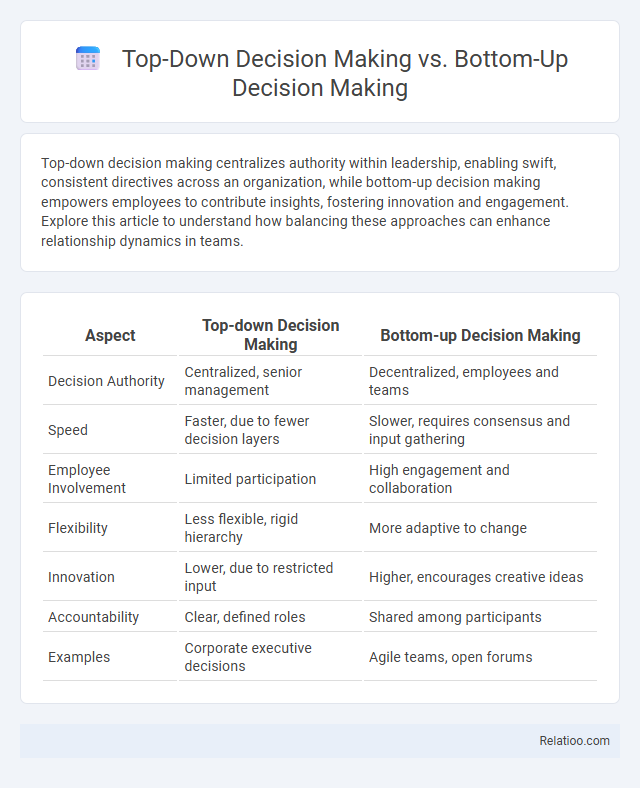Top-down decision making centralizes authority within leadership, enabling swift, consistent directives across an organization, while bottom-up decision making empowers employees to contribute insights, fostering innovation and engagement. Explore this article to understand how balancing these approaches can enhance relationship dynamics in teams.
Table of Comparison
| Aspect | Top-down Decision Making | Bottom-up Decision Making |
|---|---|---|
| Decision Authority | Centralized, senior management | Decentralized, employees and teams |
| Speed | Faster, due to fewer decision layers | Slower, requires consensus and input gathering |
| Employee Involvement | Limited participation | High engagement and collaboration |
| Flexibility | Less flexible, rigid hierarchy | More adaptive to change |
| Innovation | Lower, due to restricted input | Higher, encourages creative ideas |
| Accountability | Clear, defined roles | Shared among participants |
| Examples | Corporate executive decisions | Agile teams, open forums |
Introduction to Decision-Making Approaches
Top-down decision making involves leaders setting clear directives based on strategic goals, allowing swift execution aligned with organizational objectives. In contrast, bottom-up decision making encourages input from employees at all levels, fostering innovation and diverse perspectives that enhance solution quality. Your choice of approach depends on your organization's culture, urgency of decisions, and need for collaboration versus centralized control.
Defining Top-down Decision Making
Top-down decision making is a hierarchical approach where senior leaders define objectives and dictate actions, ensuring alignment with overall strategy. This method streamlines execution by centralizing authority and accelerating the decision process, often reducing ambiguity within teams. Emphasizing clear directives from top management, it contrasts with bottom-up decision making, which relies on input from lower organizational levels to inform strategy development.
Understanding Bottom-up Decision Making
Bottom-up decision making involves gathering insights and input from employees at various organizational levels, fostering diverse perspectives that enhance problem-solving and innovation. This approach contrasts with top-down decision making, where leaders dictate strategies and decisions without broad consultation, often limiting employee engagement and creativity. Understanding bottom-up decision making empowers you to leverage collective intelligence, improving overall strategy implementation and organizational adaptability.
Key Differences Between Top-down and Bottom-up
Top-down decision making involves leaders setting goals and directives that flow downward to employees, emphasizing control and rapid execution. In contrast, bottom-up decision making values input from lower-level employees, fostering collaboration and diverse perspectives that enhance innovation and employee engagement. Understanding these differences helps align Your strategy with the organization's culture and desired agility for effective outcomes.
Advantages of Top-down Decision Making
Top-down decision making streamlines organizational processes by enabling quick, clear directives from leadership, ensuring unified vision and consistent implementation across departments. This approach reduces decision-making time, limits ambiguity, and empowers executives to leverage their broader perspective for high-impact outcomes. It is particularly effective in crisis situations or when swift alignment on strategic goals is necessary.
Advantages of Bottom-up Decision Making
Bottom-up decision making empowers employees at all levels to contribute insights, fostering innovation and increased buy-in for organizational changes. This approach enhances problem-solving by leveraging diverse perspectives and frontline expertise, leading to more accurate and effective decisions. Your business benefits from improved morale and agility, as teams feel valued and are better equipped to respond to challenges swiftly.
Disadvantages and Challenges of Each Approach
Top-down decision making often suffers from limited input, reducing creativity and risking employee disengagement due to lack of ownership in your organization. Bottom-up decision making can slow the process as it requires extensive consensus, posing challenges in aligning diverse perspectives with strategic goals. Strategy implementation faces difficulties when either approach is misaligned with organizational culture, leading to confusion and ineffective execution.
Organizational Impact: Top-down vs Bottom-up
Top-down decision making centralizes control, enabling rapid implementation and clear accountability but may stifle employee creativity and reduce morale. Bottom-up decision making fosters innovation and higher engagement by incorporating frontline insights, though it can slow decision processes and complicate alignment. Balancing these approaches enhances organizational adaptability, ensuring strategic goals align with operational realities.
When to Use Top-down vs Bottom-up
Top-down decision making is most effective in situations requiring quick, clear directives from leadership, especially during crises or when aligning with a unified vision. Bottom-up decision making excels in environments that benefit from employee input, creativity, and diverse perspectives, enhancing buy-in and adaptability. Organizations should use top-down approaches for strategic alignment and urgent decisions, while bottom-up processes are ideal for innovation and operational improvements.
Best Practices for Effective Decision Making
Top-down decision making streamlines authority by concentrating choices among senior leaders, enhancing alignment with organizational goals but risking limited input diversity. Bottom-up decision making incorporates insights from varied employee levels, fostering innovation and buy-in while potentially slowing the process. Best practices for effective decision making balance clear strategic direction with inclusive input mechanisms, leveraging data-driven analysis, clear communication, and iterative feedback loops to optimize outcomes.

Infographic: Top-down Decision Making vs Bottom-up Decision Making
 relatioo.com
relatioo.com